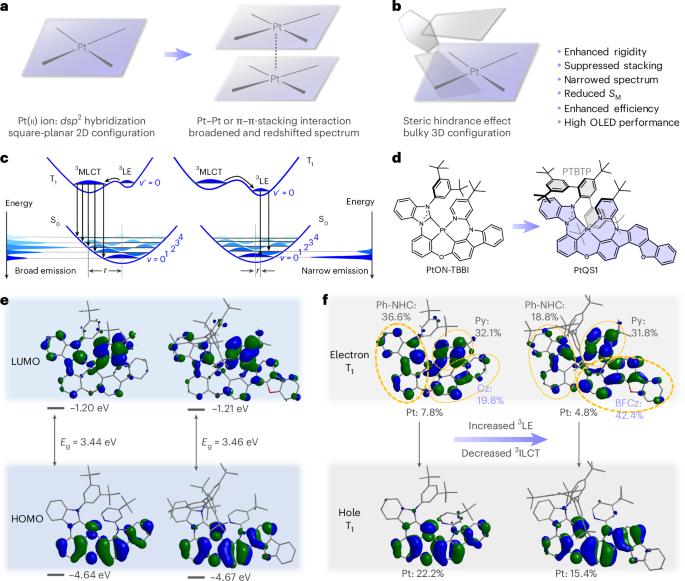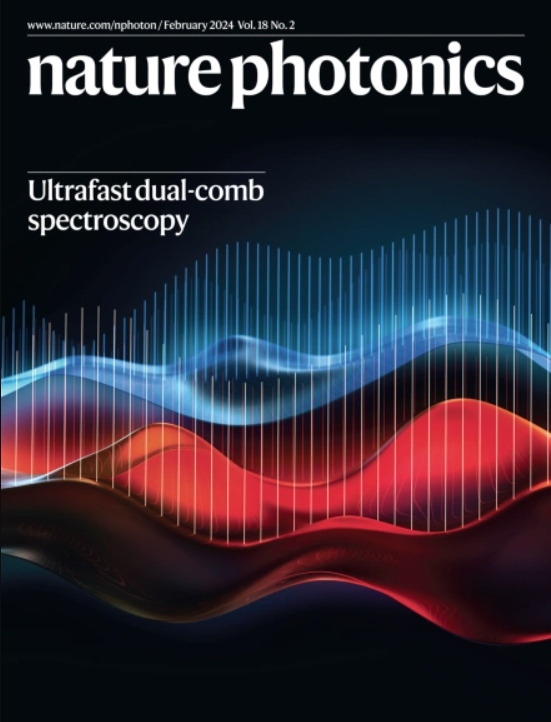High-performance deep-blue phosphorescent organic light-emitting diodes enabled by a platinum(ii) emitter
IF 32.9
1区 物理与天体物理
Q1 OPTICS
引用次数: 0
Abstract
Organic light-emitting diodes (OLEDs) represent a revolutionary technology that has been successfully commercialized in full-colour displays. However, this technology is still severely limited by the low efficiency of blue OLEDs. Developing high-performance blue OLEDs is a major challenge, and emitters are critical for overcoming this issue. Here we design phosphorescent platinum(ii) complexes with a locally excited-dominated character and a rigid three-dimensional geometry to suppress intermolecular interactions, enabling robust deep-blue devices. Bottom-emitting OLEDs emit at 464 nm with a full-width at half-maximum of 17.1 nm and high external quantum efficiencies of 30.8%, 26.4% and 23.2% at 1,000 cd m−2, 5,000 cd m−2 and 10,000 cd m−2, respectively. Top-emitting devices achieve enhanced colour purity (full-width at half-maximum of 13.1 nm, CIEy = 0.062), a low running voltage (3.9 V at 1,000 cd m−2) and a maximum blue index of 468 cd A−1 CIEy−1. These OLEDs also exhibit a long half-lifetime of 670 h at an initial luminance of 1,000 cd m−2. This study provides an important strategy to develop high-performance deep-blue phosphorescent OLEDs. A new platinum(ii)-based emitter features suppressed intermolecular interactions, enhanced molecular rigidity and locally excited character, enabling narrowband blue phosphorescent OLEDs emitting at 464 nm with a full-width at half-maximum of 17.1 nm and an external quantum efficiency of 30.8% at a luminance of 1,000 cd m−2.


高性能深蓝色磷光有机发光二极管,由铂(ii)发射器启用
有机发光二极管(oled)代表了一项革命性的技术,已经成功地在全彩显示器上实现了商业化。然而,这种技术仍然受到蓝色oled效率低的严重限制。开发高性能蓝色oled是一项重大挑战,而发射器对于克服这一问题至关重要。在这里,我们设计了磷光铂(ii)配合物,具有局部激发主导特征和刚性三维几何结构,以抑制分子间相互作用,实现鲁棒的深蓝器件。底发射oled的发射波长为464 nm,半宽为17.1 nm,在1,000 cd m−2、5,000 cd m−2和10,000 cd m−2时的外量子效率分别为30.8%、26.4%和23.2%。顶发射器件实现了更高的颜色纯度(半宽13.1 nm, CIEy = 0.062),低工作电压(3.9 V, 1,000 cd m−2)和最大蓝指数468 cd a−1 CIEy−1。在初始亮度为1,000 cd m−2时,这些oled的半衰期长达670 h。本研究为开发高性能的深蓝色磷光oled提供了重要的策略。
本文章由计算机程序翻译,如有差异,请以英文原文为准。
求助全文
约1分钟内获得全文
求助全文
来源期刊

Nature Photonics
物理-光学
CiteScore
54.20
自引率
1.70%
发文量
158
审稿时长
12 months
期刊介绍:
Nature Photonics is a monthly journal dedicated to the scientific study and application of light, known as Photonics. It publishes top-quality, peer-reviewed research across all areas of light generation, manipulation, and detection.
The journal encompasses research into the fundamental properties of light and its interactions with matter, as well as the latest developments in optoelectronic devices and emerging photonics applications. Topics covered include lasers, LEDs, imaging, detectors, optoelectronic devices, quantum optics, biophotonics, optical data storage, spectroscopy, fiber optics, solar energy, displays, terahertz technology, nonlinear optics, plasmonics, nanophotonics, and X-rays.
In addition to research papers and review articles summarizing scientific findings in optoelectronics, Nature Photonics also features News and Views pieces and research highlights. It uniquely includes articles on the business aspects of the industry, such as technology commercialization and market analysis, offering a comprehensive perspective on the field.
 求助内容:
求助内容: 应助结果提醒方式:
应助结果提醒方式:


